Mechanized Recycling of Residual Film from Typical Ridge and Mulching Crops in China: Current Status, Problems, and Recommendations for Sustainable Agricultural Development
Abstract
1. Introduction
2. Analysis of Planting Patterns of Typical Ridge and Mulching Crops
2.1. Analysis of Ridge and Mulching Planting Patterns of Potato
2.2. Analysis of Ridge and Mulching Planting Patterns of Peanuts
3. Characteristics and Distribution of Residual Film of Typical Ridge Mulching Crops
3.1. Morphological Characteristics of Residual Film
3.2. Quantity and Distribution Characteristics of Residual Film
4. Application Status and Quality Analysis of Residual Film Recycling Machinery for Typical Ridge Mulching Crop
4.1. Classification and Characteristics of Residual Film Recycling Machine for Typical Ridge Mulching Crop
4.2. Analysis of the Current Situation and Operational Quality of Residual Film Recycling Machine for Peanuts
4.3. Analysis of the Current Situation and Operational Quality of Residual Film Recycling Machine for Potatoes
5. Problems and Suggestions for the Mechanized Recovery of Plastic Film Residue from Ridge Planting and Film Mulching
5.1. Problems
- The plastic film is thin, easily broken, and hard to recycle.
- Insufficient integration of agricultural machinery and agronomy and low adaptability of residual film recycling machine
- The performance and reliability of the recycling machine needs to be improved.
- Lack of resource utilization mode of residual film, resulting in secondary pollution
5.2. Recommendations
- Accelerate the popularization and application of high-standard plastic film or fully biodegradable film.
- Strengthen the integration of agricultural machinery and agronomy.
- Strengthen the research and development, promotion, and application of residual film recycling machines.
- Establish the resource utilization system of residual film.
6. Conclusions
Author Contributions
Funding
Institutional Review Board Statement
Informed Consent Statement
Data Availability Statement
Conflicts of Interest
References
- Bian, S.Z.; Liu, X.J.; AN, Z.Y.; Wen, H.D.; Xie, Y.F.; Cao, Y.Z. Pollution status of film mulching in Chinese protected vegetable areas. Environ. Sci. Technol. 2015, 38, 76–81. [Google Scholar]
- Zhang, X.S.; Fang, X.Y.; Yu, T.Y.; Li, R.; Wu, F.K.; Jiang, F.; Wang, X.J. Application effect evaluation of PE mulch with different thickness on spring peanut. J. Agric. 2024, 14, 58–62. [Google Scholar]
- Tang, Y.Q.; Zhang, Y.L.; Wang, F.X.; Dou, Y.Q.; Li, D.; Feng, S.Y. Effects of different degradable film and ordinary plastic film on soil hydrothermal conditions and peanut growth. J. Irrig. Drain. 2024, 43, 17–27. [Google Scholar]
- Huang, T.T.; Wu, Q.X.; Yuan, Y.Y.; Zhang, X.T.; Sun, R.Q.; Hao, R.; Yang, X.H.; Li, C.F.; Qin, X.H.; Song, F.Q.; et al. Effects of plastic film mulching on yield, water use efficiency, and nitrogen use efficiency of different crops in China: A meta-analysis. Field Crops Res. 2024, 312, 109407. [Google Scholar] [CrossRef]
- Wang, P.; Chen, X.G.; Wen, H.J. Research and experiment on the removal mechanism of light impurities of the residual mulch film recovery machine. Agriculture 2022, 12, 775. [Google Scholar] [CrossRef]
- Kasirajan, S.; Ngouajio, M. Polyethylene and biodegradable mulches for agricultural applications: A review. Agron. Sustain. Dev. 2012, 32, 501–529. [Google Scholar] [CrossRef]
- Yan, C.R.; Hou, J.Y.; Xu, Y.Y.; Hong, Z.J.; Ma, Z.G.; Cui, J.X. Plastic mulch film application and management: Experience from developed countries. J. Agro-Environ. Sci. 2024, 43, 1288–1293. [Google Scholar]
- Thidar, M.; Gong, D.Z.; Mei, X.R.; Gao, L.L.; Li, H.R.; Hao, W.P.; Gu, F.X. Mulching improved soil water, root distribution and yield of maize in the Loess Plateau of Northwest China. Agric. Water Manag. 2020, 241, 106340. [Google Scholar] [CrossRef]
- Li, X.Y.; Shi, H.B.; Lü, Y.; Wang, Z.C.; Lin, Y.X.; Li, X. Effects of different residual plastic film quantities in soil on drip infiltration and its uncertainty analysis. Trans. Chin. Soc. Agric. Eng. 2013, 29, 84–90. [Google Scholar]
- Li, Y.Q.; Zhao, C.X.; Yan, C.R.; Mao, L.L.; Liu, Q.; Li, Z.; He, W.Q. Effects of agricultural plastic film residues on transportation and distribution of water and nitrate in soil. Chemosphere 2020, 242, 125131. [Google Scholar]
- Hao, X.; Zhang, J.; Zang, X.W.; Yi, M.L.; Wang, M.; Dong, W.Z.; Zhang, X.Y.; Tang, F.S. Analysis of the mulching film utilization and its residue pollution in peanut fields of Henan Province. Soils Crops 2019, 8, 43–49. [Google Scholar]
- Dong, H.G.; Liu, T.; Li, Y.G.; Liu, H.F.; Wang, D. Effects of plastic film residue on cotton yield and soil physical and chemical properties in Xinjiang. Trans. Chin. Soc. Agric. Eng. 2013, 29, 91–99. [Google Scholar]
- Li, Y.Q.; He, W.Q.; Yan, C.R.; Mao, L.L.; Liu, S. Effect of residual film on soil infiltration under drip irrigation. Trans. Chin. Soc. Agric. Eng. 2015, 31, 145–149. [Google Scholar]
- Ma, H.; Mei, X.R.; Yan, C.R.; He, W.Q.; Li, K. The residue of mulching plastic film of cotton field in North China. J. Agro-Environ. Sci. 2008, 27, 570–573. [Google Scholar]
- Zhang, J.F.; Liang, J.; Luo, S.Y.; Yao, Z.M.; Tian, C.J.; Sun, Y. Current situation and countermeasures of residual plastic film pollution in farmland. Soils Crops 2022, 11, 385–397. [Google Scholar]
- Li, Z.R.; Ma, J.J.; Sun, X.H.; Guo, X.H.; Zheng, L.J.; Chen, J.P. Plastic pollution in soil and crops: Effects of film residuals on soil water content and tomato physiology. Agronomy 2022, 12, 1222. [Google Scholar] [CrossRef]
- Zang, H.D.; Zhou, J.; Marshall, M.R.; Chadwick, D.R.; Wen, Y.; Jones, D.L. Microplastics in the agroecosystem: Are they an emerging threat to the plant-soil system? Soil Biol. Biochem. 2020, 148, 107926. [Google Scholar] [CrossRef]
- Zhai, Z.Q.; Chen, X.G.; Zhang, R.Y.; Qiu, F.S.; Meng, Q.J.; Yang, J.K.; Wang, H.Y. Evaluation of residual plastic film pollution in pre-sowing cotton field using UAV imaging and semantic segmentation. Front. Plant Sci. 2022, 13, 991191. [Google Scholar] [CrossRef]
- Dong, J.H.; Wang, J.; Bi, X.S.; Zheng, Y.J.; Wang, G.H.; Wang, J.K.; Chen, Y.; Jia, J. Analysis and test of clamp conveying type residual film recycling and film impurity separation mechanism. Processes 2022, 10, 1816. [Google Scholar] [CrossRef]
- Liu, X.L.; Zhao, W.Y.; Zhang, H.; Wang, G.P.; Sun, W.; Dai, F.; Li, H.; Xin, S.L. Design and experiment of an upper-side-discharge straw-returning and bundle self-unloading integrated corn residual film recycling machine. Int. J. Agric. Biol. Eng. 2023, 16, 61–70. [Google Scholar] [CrossRef]
- Zhuo, H.M.; Fu, S.Z.; Liu, H.; Song, H.; Ren, L.J. Analyses and suggestions on current situation of potato industry standards in China. J. Anhui Agric. Sci. 2019, 47, 248–250+270. [Google Scholar]
- Xu, Y.; Jiang, L.H.; Shi, J.; Tan, D.S.; Li, Z.E. Analysis on film residual status of typical mulching crops in Shandong Province. Shandong Agric. Sci. 2018, 50, 91–95. [Google Scholar]
- Wei, Z.C.; Han, M.; Su, G.L.; Zhang, H.; Li, X.Q.; Jin, C.Q. Design and experiment of a bagging and unloading potato combine harvester. Trans. Chin. Soc. Agric. Mach. 2023, 54, 92–104. [Google Scholar]
- Lyu, J.Q.; Zhang, X.Z.; Xiao, X.X.; Li, J.C.; Yang, D.Q.; Sun, Q. Design and experiment of key components of large monopoly double row potato mulching device. J. Northeast. Agric. Univ. 2023, 54, 88–96. [Google Scholar]
- Jiang, D.L.; Yan, L.M.; Chen, X.G.; Mo, Y.S.; Yang, J.C. Design and experiment of nail tooth picking up device for strip type residual film recycling and baling machine. Int. J. Agric. Biol. Eng. 2023, 16, 85–96. [Google Scholar] [CrossRef]
- You, Z.Y.; Gu, F.W.; Wu, F.; Hu, Z.C.; Zhang, Y.L.; Tu, L.B. Research on ridged peanut residue plastic film recycling technology. J. Agric. Mech. Res. 2016, 38, 207–211. [Google Scholar]
- Wang, X.X.; Song, N.N.; Xue, Y.H.; Wang, J.C.; Liang, L.N.; Li, M.J.; Liu, S.L.; Liu, D.S. Occurrence characteristics of residual film in cultivated soil of peanut planting area in Shandong Province, China. J. Agro-Environ. Sci. 2021, 40, 1729–1737. [Google Scholar]
- Zhang, D.; Hu, W.L.; Liu, H.B.; Du, L.F.; Xu, Y.; Cheng, Z.H.; Sun, S.Y.; Wang, H.Y. Characteristics of residual mulching film and residual coefficient of typical crops in North China. Trans. Chin. Soc. Agric. Eng. 2016, 32, 1–5. [Google Scholar]
- Sun, C.; Shan, N.N.; Yang, Z.Y.; Wu, Z.Q.; Wang, Y.F. Analysis of impact factors of plastic film residue on farmland in Xinjiang. J. Environ. Eng. Technol. 2024, 5, 1627–1634. [Google Scholar]
- Li, L.L.; Dai, L.Y.; Gao, W.C.; Zhang, S.Y.; Liu, T.Z. The occurrence characteristics and influencing factors of residual mulching film of typical farmland with plastic film in Guizhou province. Ecol. Environ. Sci. 2022, 31, 2189–2197. [Google Scholar]
- Shen, Y.; Liang, C.L.; Liu, Y.; Tian, M.; Qian, X.Q. Present situation of agricultural film use in China and pollution prevention measures. Mod. Agric. Sci. Technol. 2023, 12, 147–151+159. [Google Scholar]
- Zhao, J.J.; Tang, J.R.; Li, C.X.; He, H.Q.; Huang, H. Distribution and influencing factors of plastic film residues in topsoil of farmland in Gansu Province. Chin. J. Eco-Agric. 2024, 32, 456–467. [Google Scholar]
- Bai, X.; Zhou, H.P.; Xie, W.Y. Investigation on utilization status of agricultural film and residual membrane pollution in typical areas of Shanxi province. Chin. Agric. Sci. Bull. 2017, 33, 99–104. [Google Scholar]
- Liang, R.; Zhu, Z.J.; Peng, C.; Bian, Z.J.; Yang, X.M.; Wang, H.; Wang, X.X. Mulch film to plastic debris: A survey of agricultural soils of Hebei Province, North China. Sci. Total Environ. 2024, 918, 170509. [Google Scholar] [CrossRef]
- Zhan, Y.; Chen, X.G.; Wen, H.J.; Zheng, X.; Niu, Q.; Kang, J.M. Research status and prospect of control technology for residual plastic film pollution in farmland. Trans. Chin. Soc. Agric. Mach. 2017, 48, 1–14. [Google Scholar]
- Shi, Z.L.; Zhang, X.J.; Yan, J.S.; Jiang, Y.W.; Yao, J.T. Experiment and analysis of film-soil separation motion characteristics of a chain drive residual film recovery mechanism for the tillage layer. Appl. Sci. 2022, 12, 5884. [Google Scholar] [CrossRef]
- Wen, H.J.; Chen, X.G.; Chen, H.; Gou, H.X. Application status and development of farmland mulch recycling machinery. J. Agro-Environ. Sci. 2024, 43, 1271–1277. [Google Scholar]
- Li, D.; Zhao, W.Y.; Xin, S.L.; Liu, X.L.; Qu, H.; Xu, Y. Current situation and prospect of recycling technology of farmland residual film. J. Chin. Agric. Mech. 2020, 41, 204–209. [Google Scholar]
- Zhou, X.X.; Hu, Z.C.; Yan, W.; You, Z.Y.; Wu, N. Research status of domestic residual film recovery machine to take off the film device. J. Agric. Mech. Res. 2016, 38, 263–268. [Google Scholar]
- Xue, S.K.; Chen, X.G.; Li, J.B.; Wang, X.F.; Zhang, Z.Y. Design of and Experiment on a Film Removal Device of an Arc-Toothed Residual Film Recovery Machine before Sowing. Appl. Sci. 2021, 11, 8551. [Google Scholar] [CrossRef]
- Chen, Y.Q.; Hu, Z.C.; Wu, F.; Gu, F.W.; Xu, H.B.; You, Z.Y.; Shi, L.L. Research key points and practice on residual film recycling equipment in China. Xinjiang Agric. Mech. 2016, 5, 8–11. [Google Scholar]
- Xu, H.B.; Xu, H.B.; Wu, F.; Gu, F.W. Study on the collecting component of plastic film residue collector. J. Agric. Mech. Res. 2016, 38, 242–249. [Google Scholar]
- Shi, Z.L.; Zhang, X.J.; Liu, X.P.; Guo, L.; Zhang, C.S.; Liu, L. Design and test of roll-type tillage layer residual film recovery machine. Trans. Chin. Soc. Agric. Mach. 2024, 55, 128–137. [Google Scholar]
- Peng, Q.J.; Li, K.K.; Wang, X.Y.; Zhang, G.H.; Kang, J.M. Design and test of stripping and impurity removal device for spring-tooth residual plastic film collector. Agriculture 2023, 13, 42. [Google Scholar] [CrossRef]
- Wang, X.Z.; Hong, T.Y.; Fang, W.Q.; Chen, X.Y. Optimized design for vibration reduction in a residual film recovery machine frame based on modal analysis. Agriculture 2024, 14, 543. [Google Scholar] [CrossRef]
- Shi, Z.L.; Zhang, X.J.; Liu, X.P.; Kang, M.C.; Yao, J.T.; Guo, L. Analysis and test of the tillage layer roll-type residual film recovery mechanism. Appl. Sci. 2023, 13, 7598. [Google Scholar] [CrossRef]
- Wang, J.K.; Fu, W.; Wang, W.B.; Li, B. Design of SMS-1500 type straw chopping and plastic film residue collecting machine. Trans. CSAE 2011, 27, 168–172. [Google Scholar]
- Ke, Z.R.; Yang, S.M.; Zhang, F.; Ma, Y.L. Design and experiment of a toothed chain residual membrane recycling machine. J. Gansu Agric. Univ. 2024, 59, 313–322. [Google Scholar]
- Su, Z.P.; Li, J.P.; Zhang, Z.Y.; Ren, S.X.; Shi, Y.M.; Wang, X.F. Analysis of the mechanical properties and wear characteristics of nail teeth based on sowing layer residual film recovery machine. Eng. Fail. Anal. 2023, 143, 106869. [Google Scholar] [CrossRef]
- Shi, L.L.; Hu, Z.C.; Gu, F.W.; Wu, F.; Wu, P.L. Design and parameter optimization on teeth residue plastic film collector of ridged peanut. Trans. Chin. Soc. Agric. Eng. 2017, 33, 8–15. [Google Scholar]
- You, Z.Y.; Hu, Z.C.; Wu, H.C.; Zhang, Y.P.; Yan, J.C.; Yan, W.; Zhou, X.X. Design and experiment of 1MCDS-100A typed shovel-sieve residual film recovery machine. Trans. Chin. Soc. Agric. Eng. 2017, 33, 10–18. [Google Scholar]
- Gu, M.; Hu, Z.C.; You, Z.Y.; Xu, H.B.; Ji, G.S.; Wu, N. Optimization design and comparison test of transport and separation mechanism of network chain residual Plastic film collector. J. Agric. Mech. Res. 2020, 42, 58–64. [Google Scholar]
- NY/T 1227-2019; Retrieving Machines for Residual Film-Operation Quality. Ministry of Agriculture and Rural Affairs of the People’s Republic of China: Beijing, China, 2018.
- Xin, R.F.; Li, H.L.; Zhao, W.Y.; Liu, X.L.; Sun, W.; Zhang, H.; Li, H.; Wang, Z.Y.; Wei, L. Research status and development trend of potato mechanized residual film recycling. For. Mach. Woodwork. Equip. 2023, 51, 16–22. [Google Scholar]
- Fang, W.Q.; Wang, X.Z.; Han, D.L.; Zang, N.; Chen, C.G.; Ohiemi, I.E. Parameter optimization and disturbance analysis of the film picking device of the chain-type plough layer residual film recovery machine based on DEM-MBD coupling. Comput. Electron. Agric. 2024, 222, 109041. [Google Scholar] [CrossRef]
- Zhang, M.J.; Jian, J.M.; Wang, F.L.; Li, W.; San, Y.L.; Guo, W.S.; Hou, S.L.; Xue, D.Q. Design and experimental study on belt-tooth type collector for potato film residues. Earth Environ. Sci. 2019, 252, 042092. [Google Scholar] [CrossRef]
- Dai, F.; Zhao, W.Y.; Sun, W.; Wu, W.Z.; Song, X.F.; Li, Y. Design and experiment of combined operation machine for potato harvesting and plastic film pneumatic auxiliary collecting. Trans. Chin. Soc. Agric. Mach. 2017, 48, 64–72. [Google Scholar]
- Li, Y.; Zhao, W.Y.; Dai, F.; Shi, L.R.; Guo, X.H. Development and experiment of combined operation machine for potato harvesting and plastic film collecting. J. Hunan Agric. Univ. (Nat. Sci.) 2016, 42, 102–107. [Google Scholar]
- Dai, F.; Guo, X.H.; Zhao, W.Y.; Xin, S.L.; Liu, X.L.; Wu, W.Z. Design and experiment of canvas belt combined operation machine for potato digging and plastic film collecting. Trans. Chin. Soc. Agric. Mach. 2018, 49, 104–113. [Google Scholar]
- Ma, Y.L.; Yang, S.M.; Li, M.Q.; Wang, Q.; Ke, Z.R. Design of integrated machine for potato harvesting and residual film collecting in complex terrain. J. Hebei Univ. (Nat. Sci. Ed.) 2022, 42, 569–579. [Google Scholar]
- Sun, W.; Wang, C.F.; Zhao, W.Y.; Zhang, H.; Liu, X.L.; Wu, J.L. Design and experiment of potato digger with waste film recollection for complete film mulching, soil covering and ridge sowing pattern. Trans. Chin. Soc. Agric. Mach. 2018, 49, 105–114. [Google Scholar]
- Ju, Y.; Sun, W.; Zhao, Z.; Wang, H.; Liu, X.; Zhang, H.; Li, H.; Simionescu, P.A. Development and testing of a self-Propelled machine for combined potato harvesting and residual plastic film retrieval. Machines 2023, 11, 432. [Google Scholar] [CrossRef]
- NY/T 648-2015; Technical Specification for Quality Evaluation for Potato Harvesters. Ministry of Agriculture and Rural Affairs of the People’s Republic of China: Beijing, China, 2015.
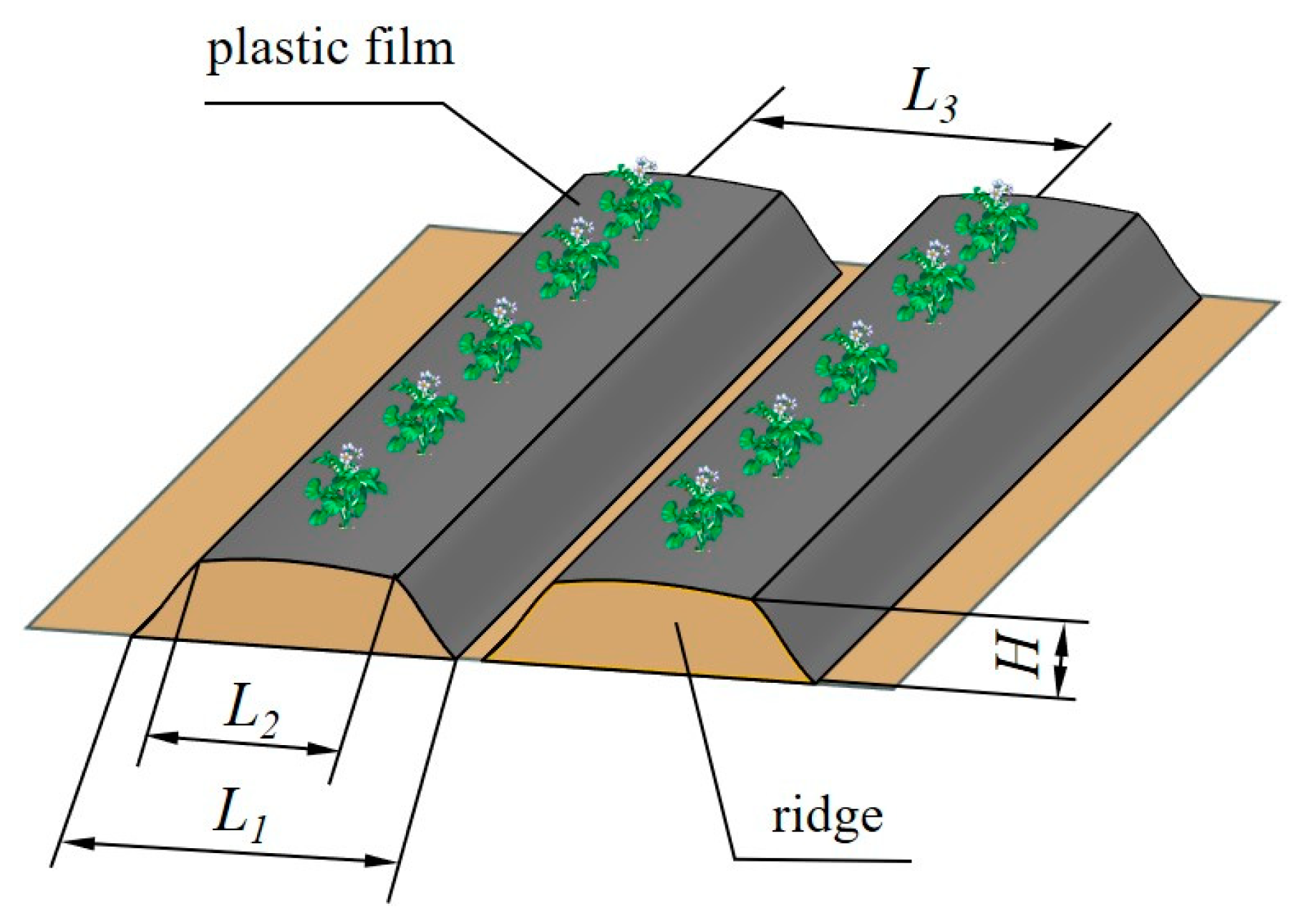
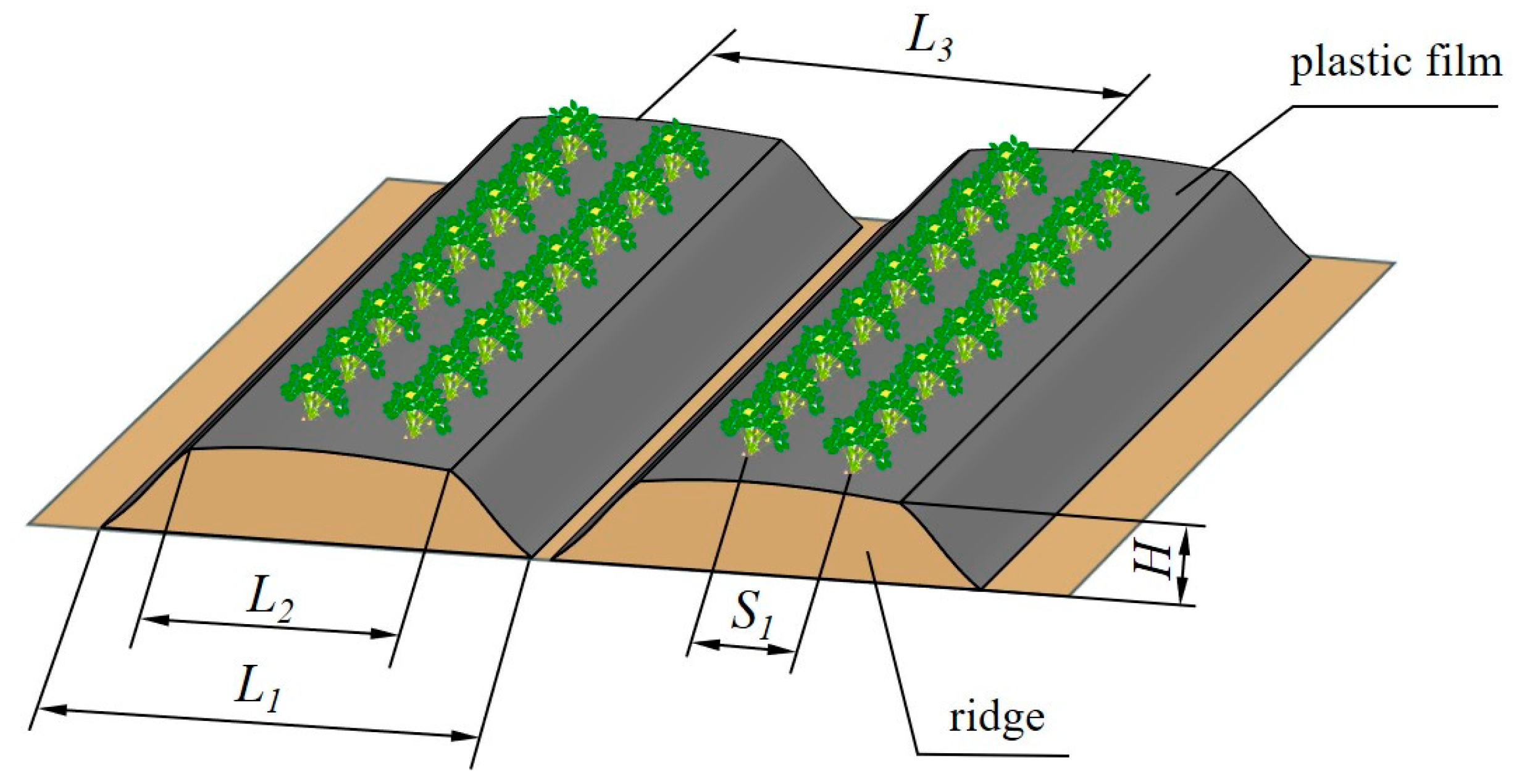
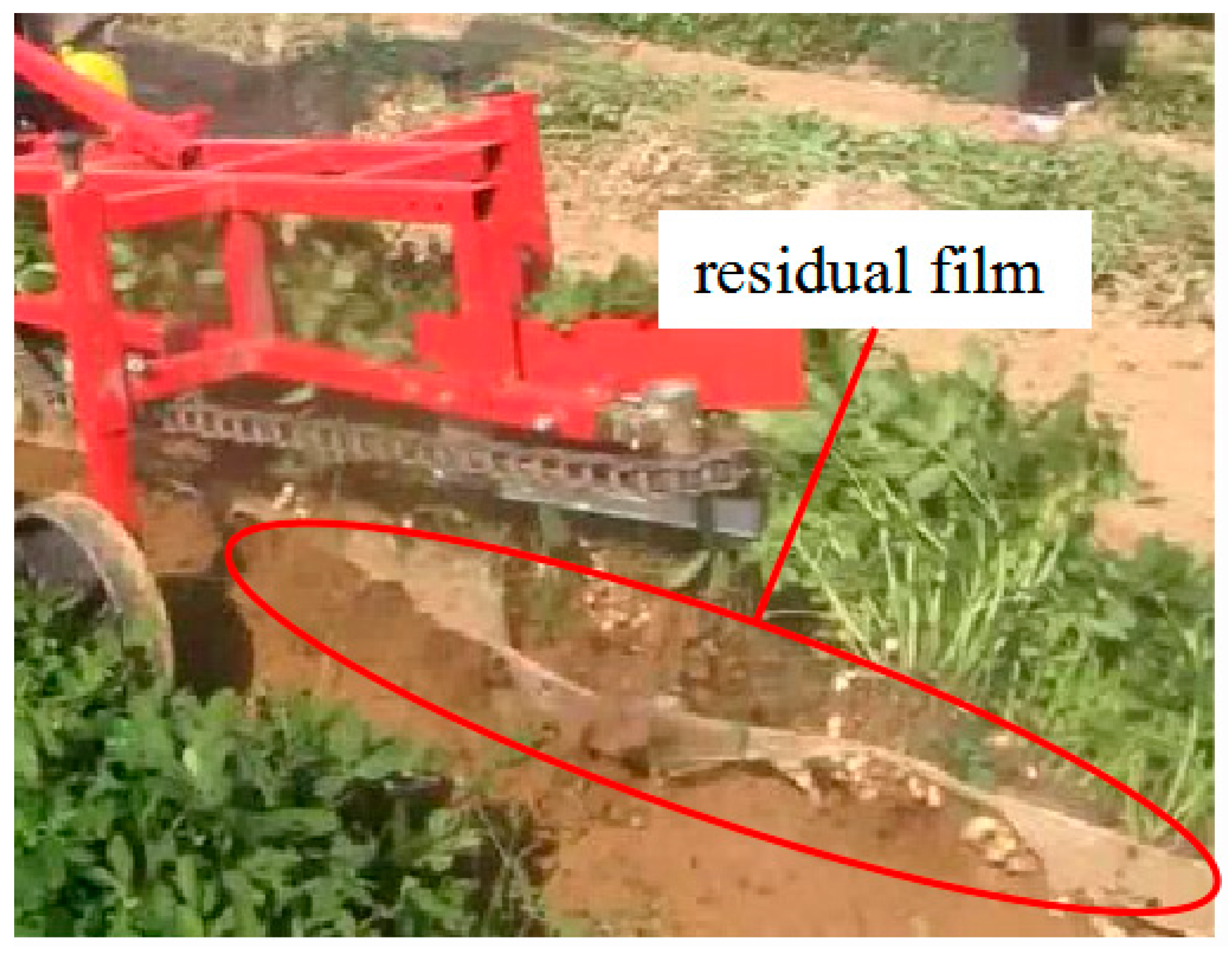
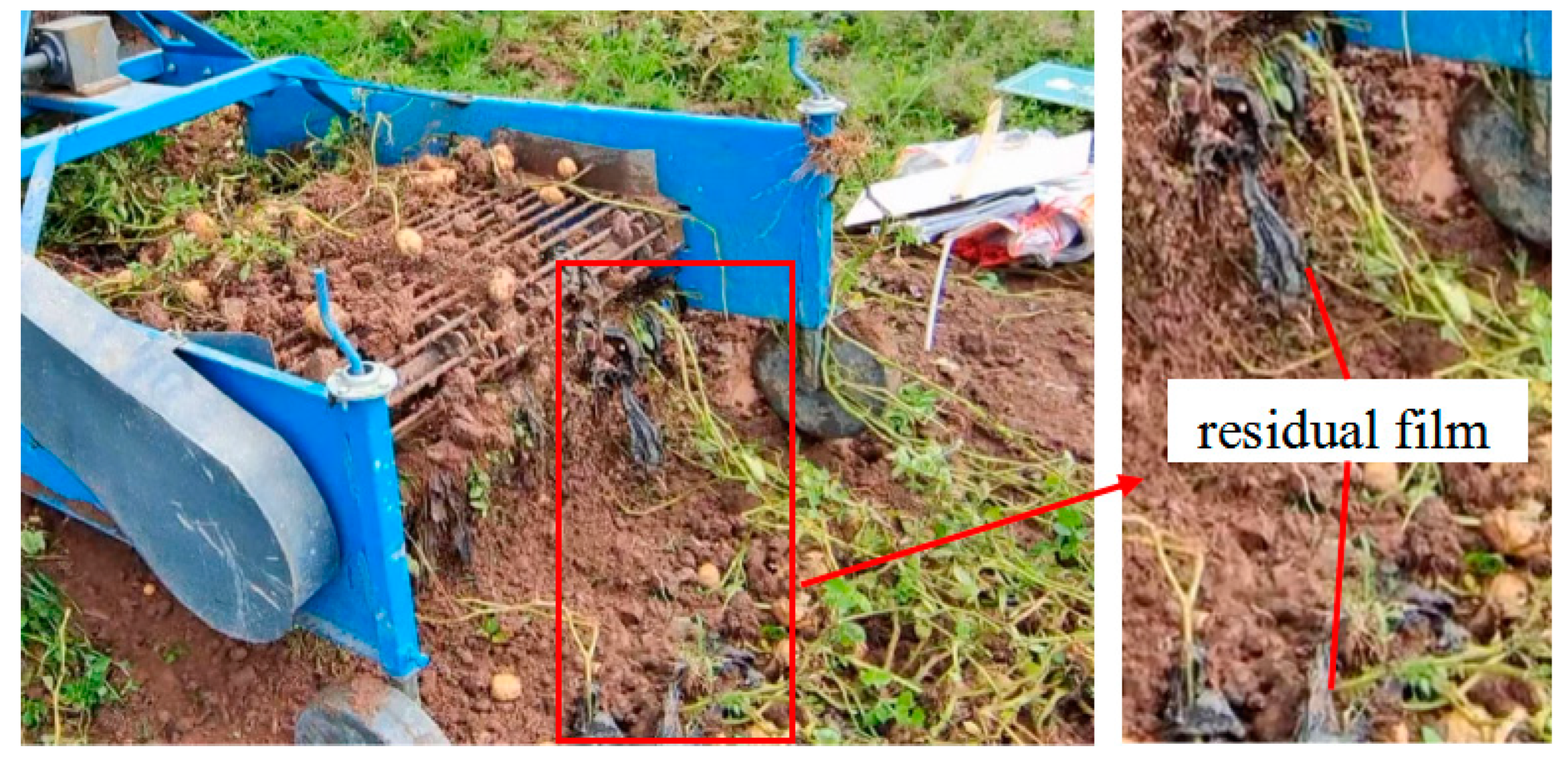
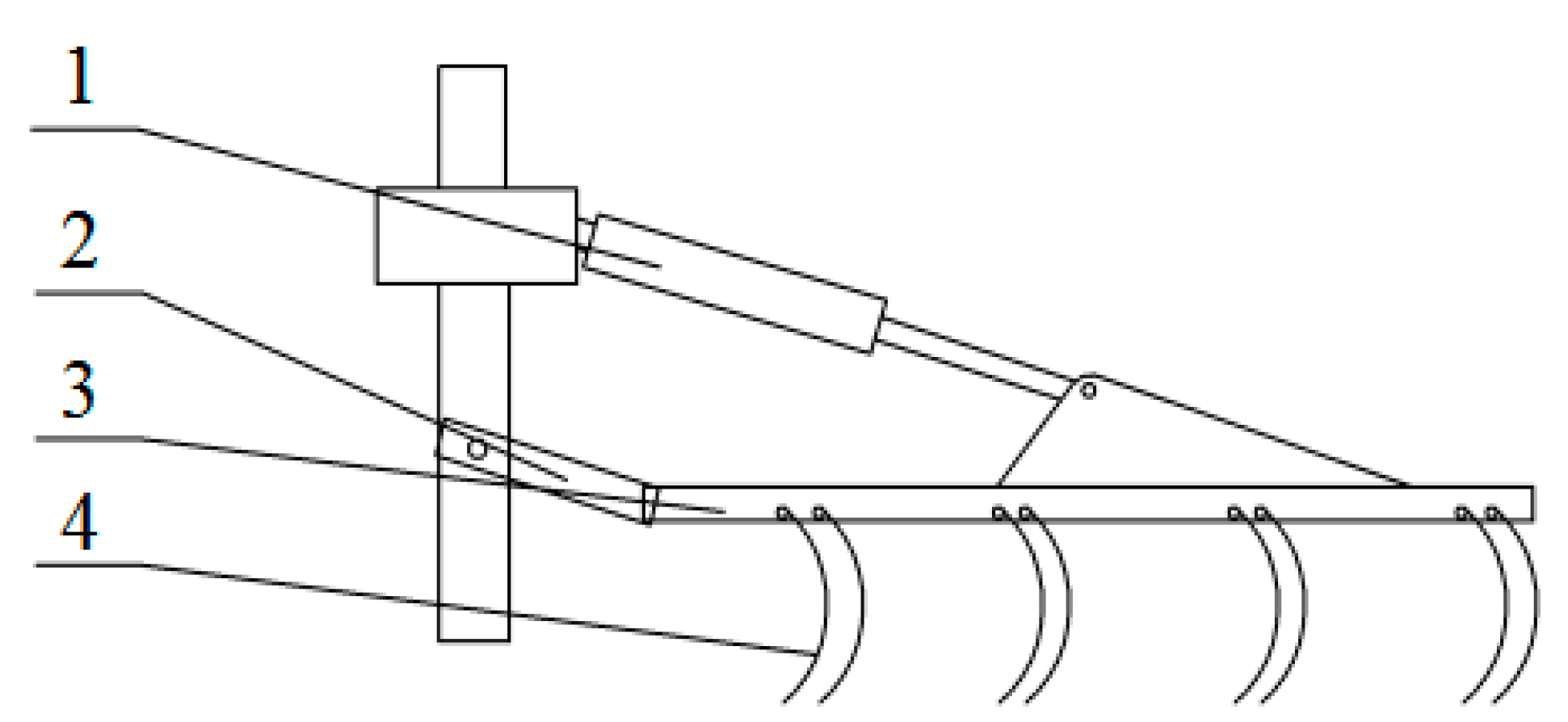
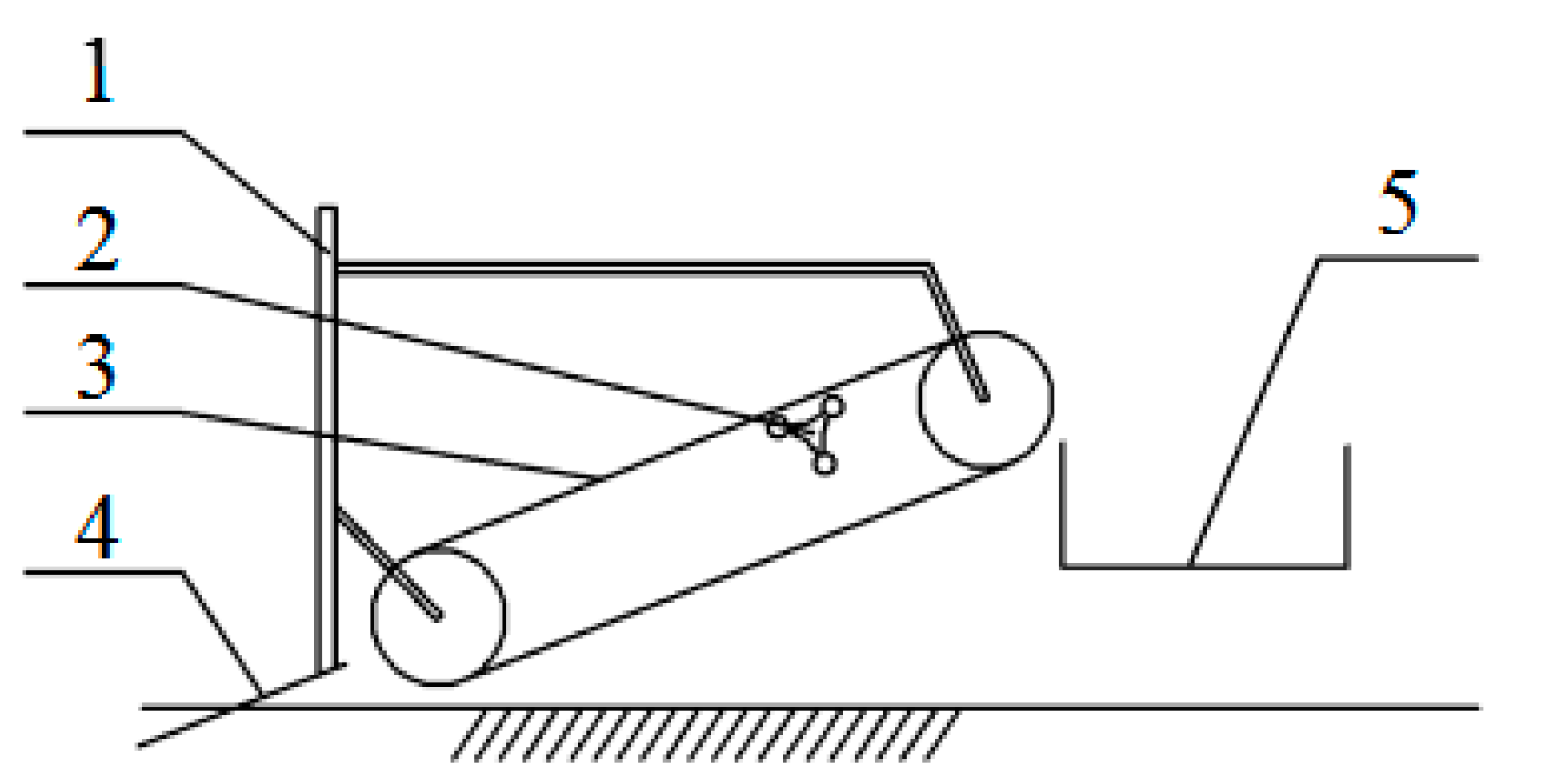

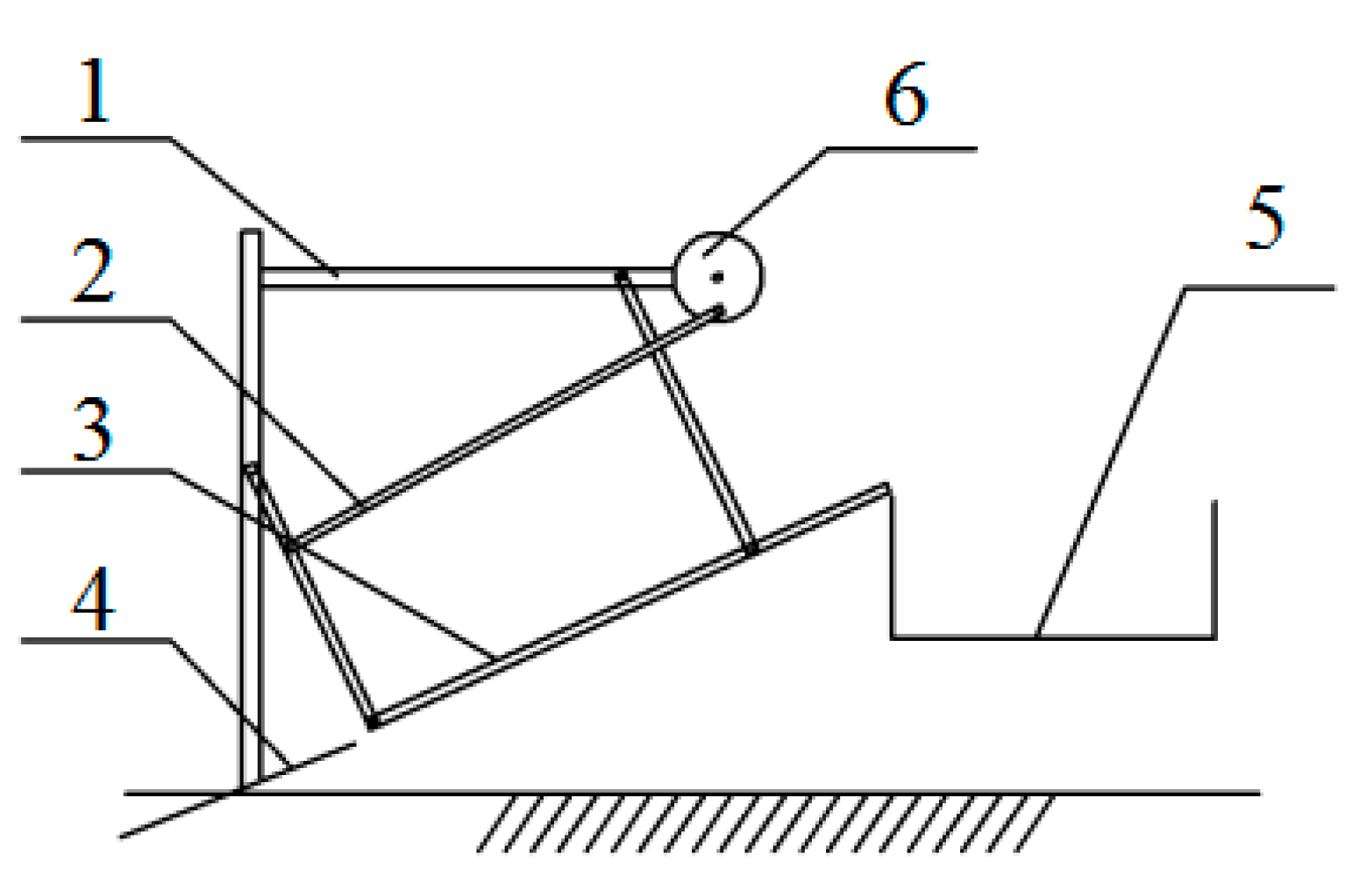
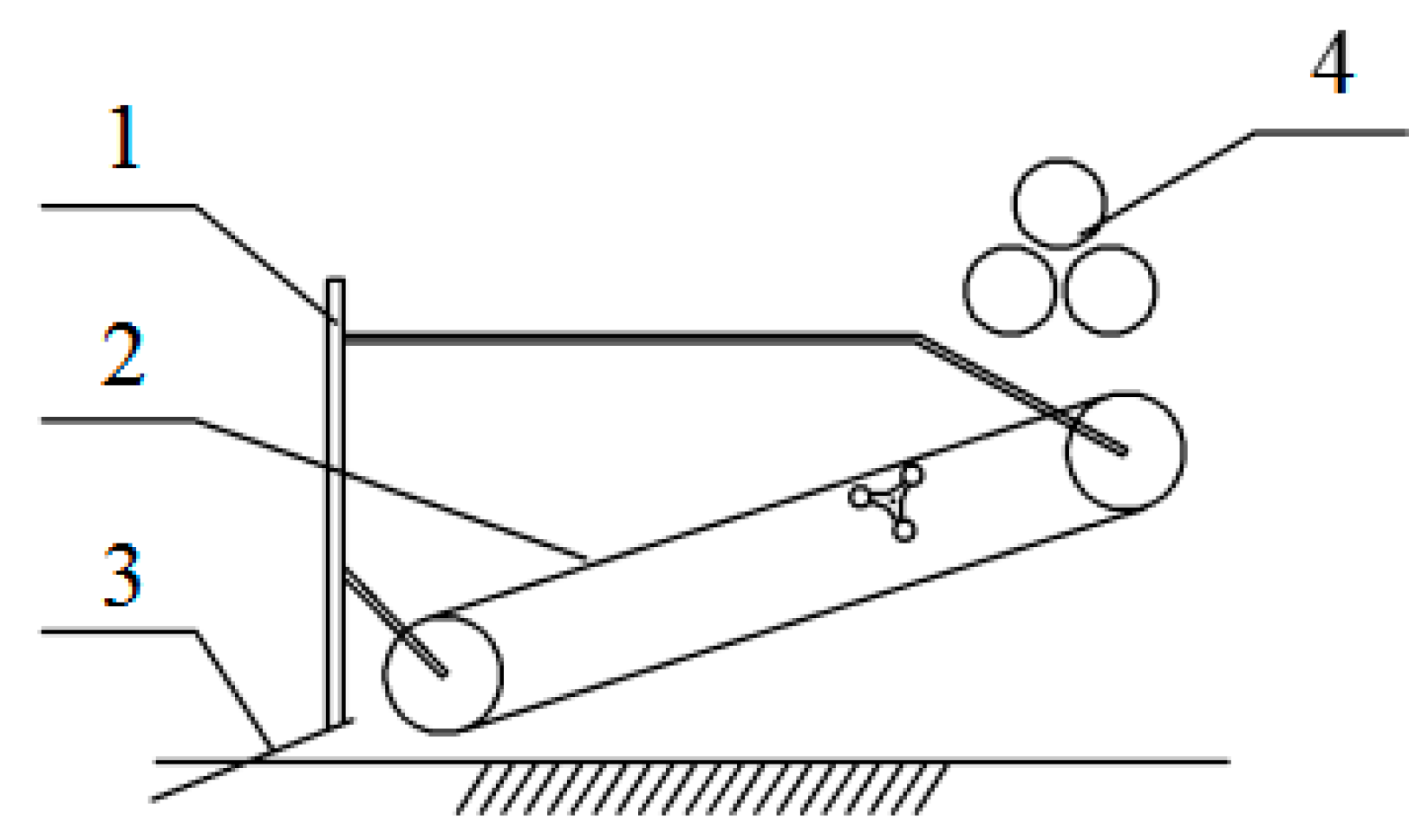
| Crops | Province | Area | Thickness of Plastic Film (mm) | Quantity of Residual Film (kg·hm−2) | References |
|---|---|---|---|---|---|
| Peanut | Henan | - | 0.004~0.006 | 15~40 | [11] |
| Shandong | Jiaodong Peninsula | 0.008~0.01 | 2.48~46.01 | [27] | |
| Southern and central areas of Shandong Province | 0.008~0.01 | 4.11~38.5 | |||
| The plain of west Shandong | 0.008~0.01 | 4.05~40.61 | |||
| The plain of north Shandong | 0.008~0.01 | 3.07~29.65 | |||
| Hebei | - | 0.004~0.005 | 44.6~64.5 | [28] | |
| Potato | Gansu | - | ≥0.01 | 7.46~23.26 | [32] |
| Anhui | - | 0.007~0.017 | 19.02 | [33] |
| Depth of Soil | Proportion of Residual Film | Size of Residual Film | References |
|---|---|---|---|
| 0~100 mm | 60~90% | Large | [11,27,28,32,33] |
| 100~200 mm | 8.5~30% | Large and medium | |
| 200~300 mm | 1.5~10% | Small |
| Type | Structure | Characteristics | Work Stage |
|---|---|---|---|
| post-harvest film recycling | rake-toothed | As shown in Figure 5, the structure is relatively simple and easy to maintain. It performs well on flat land, but its efficiency is low. Frequent manual unloading of the film is required, as film accumulation can negatively impact the picking effect. On uneven terrain, the film cannot be fully collected. | pre-sowing or post-harvest |
| shovel-chain | As shown in Figure 6, the soil and residual film are shoveled up and transported by a conveyor to the film–soil separation device. The structure is simple and effective for handling both large and small pieces of residual film. However, it places high demands on the subsequent processes of film–soil separation and film impurity removal. | post-harvest | |
| toothed chain | As shown in Figure 7, the toothed chain film-picking mechanism is mainly composed of film-picking teeth, chain wheels, and film support plates. When working, the picking teeth rotate with the conveyor chain to pick up the residual film supported by the film shovel and drive them to move along with the conveyor chain to the collecting box. This type of mechanism is not suitable for small residual films. It is easy to entangle the film and bring debris into the film collection component, making it difficult to separate the film debris [47,48,49]. | seedling stage or post-harvest | |
| shovel-sieve | As shown in Figure 8, it consists of a digging shovel, conveyor chain, and separation drum or vibrating screen, with a high residual film recovery rate. The recovery effect is better in sandy soil. However, the power consumption is relatively high. | post-harvest | |
| Film recycling during harvesting | shovel-chain | As shown in Figure 9, it consists of a digging shovel, conveyor chain, film roller, etc. The plastic film is collected during fruit harvesting. This way is highly efficient and avoids secondary operations. It is mainly used for potato residual film recycling. | during harvesting |
| Name | Picture | Structure/Characteristics | References |
|---|---|---|---|
| Rake-toothed residual film recycling machine | 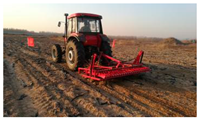 | A hydraulic-driven parallel four-bar linkage synchronous device has been invented to solve the problem of manual film removal and time-consuming and labor-intensive processes in traditional rake-toothed machines. To solve the problems of incomplete and difficult film removal, an “inverted eight shaped” scraper and limit rail return mechanism have been designed, achieving efficient and smooth film collection, complete film removal in one operation, and smooth scraper return. It is matched with a 70 hp tractor, and the work efficiency is about 0.3~1.19 hm2/h. | [50] |
| Shovel–sieve residual film recycling machine |  | This type of machine consists of a digging shovel, film separating board, reciprocating motion of the double-sieve device, depth-controlled device, and film collecting basket, which can complete the excavation of the film, film transfer, soil cleaning, and film collection operations in one go. It is matched with a 25~40 hp tractor, and the work efficiency is about 0.3~0.4 hm2/h. | [51] |
| Mesh chain type residual film recycling machine | 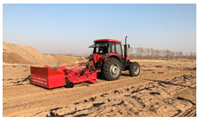 | The mesh chain type residual plastic film recycling machine consists of a digging shovel, mesh chain, soil broken roller, double-acting excitation device, and film collecting device, which can solve the problems of plastic film leakage and back and twine in the process of conveying. It is matched with a 110 hp tractor, and the work efficiency is about 0.3 hm2/h. | [52] |
| Name | Net Collected Rate | Film Wrapping Rate | References | ||
|---|---|---|---|---|---|
| Test Value | Industrial Standard | Test Value | Industrial Standard | ||
| Rake-toothed residual film recycling machine | 93% | ≥80% | - | ≤2% | [50] |
| Shovel–sieve residual film recycling machine | 91.26% | 4.27% | [51] | ||
| Mesh chain type residual film recycling machine | 93.15% | - | [52] | ||
| Name | Picture | Structure/Characteristics | References |
|---|---|---|---|
| Combined operation machine for potato harvesting and plastic film pneumatic auxiliary collecting | 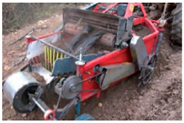 | The combined operation machine is designed for the cultivation pattern of double potato rows on a big ridge. It consists of a ladder digging blade composed of an excavation section, a broken soil section, a loose section, a soil-potato dither conveyor device, a centrifugal fan, and a floating pneumatic curl-up film mechanism composed of a film roller, floating chute frame, and lifting chain. The working width is 900 mm. It is matched with a 30–40 hp tractor, and the work efficiency is about 0.16~0.25 hm2/h. | [57] |
| Combined operation machine for potato harvesting and plastic film collecting | 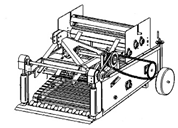 | On the basis of the 4U-83 potato harvester, the shovel was optimized to increase the effect of film lifting. A crank-rocker residual film striping mechanism and a cylinder residual film collecting and unloading device were designed. It is matched with a 30–40 hp tractor. | [58] |
| Canvas belt combined operation machine for potato digging and plastic film collecting |  | The combined operation machine is designed for the cultivation pattern of double potato rows on a big ridge, which consists of one anti-twining device on each side, a film transporting device, including three canvas belts, and a floating film rolling mechanism, including three rollers. It is matched with a 30–40 hp tractor, and the work efficiency is about 0.16~0.25 hm2/h. | [59] |
| Integrated machine for potato harvesting and residual film collecting | 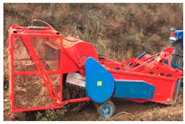 | This machine consists of a digging shovel, a conveyor device, and a residual film collecting mechanism. The conveyor device includes an S-shaped separation section and a soil–potato dither separation section. The pneumatic residual film recovery mechanism is mainly composed of a rotating shaft, blade, shell, air inlet, and air outlet. It is matched with a 60–75 hp tractor, and the work efficiency is about 0.2 hm2/h. | [60] |
| Potato digger with waste film recollection for complete film mulching | 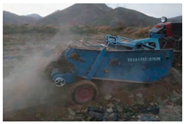 | This machine consists of a bionic digging device, whose digging angle can be changed, an anti-blocking mechanism, which is made up of a crank-rocker, a potato–soil separation device, including a separating screen, shaking wheel, lifting wheel, and scraper, and a potato-film partition device, including special sprockets and chains and a cone-shaped film rolling device. It is matched with a 30–40 hp tractor, and the work efficiency is about 0.15~0.27 hm2/h. | [61] |
| Self-propelled machine for combined potato harvest and residual plastic film retrieval | 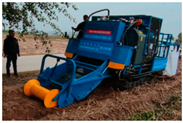 | This machine mainly consists of a digging and lifting device, which includes a digging shovel, a shovel angle and a digging depth adjusting mechanism, a lifting chain, a potato-film separation device, and a residual plastic film recovery and bundling device, which includes eight film rolling rollers, eight roller sprockets, a driving chain, and a rotating shaft. It is matched with a 100 hp engine, and the work efficiency is about 0.16~0.32 hm2/h. | [62] |
| Name | Net Collected Rate | Potato Loss Rate | Potato Damage Rate | References | ||
|---|---|---|---|---|---|---|
| Value of Experiment | Value of Standard | Value of Experiment | Value of Standard | |||
| Combined operation machine for potato harvesting and plastic film pneumatic auxiliary collecting | 91.6% | 3.2% | ≤4% | 2.3% | ≤2% (version 2015) ≤5% (version 2002) | [57] |
| Combined operation machine for potato harvesting and plastic film collecting | 89.3% | 3.6% | 4.4% | [58] | ||
| Canvas belt combined operation machine for potato digging and plastic film collecting | 92.1% | 3.4% | 2.2% | [59] | ||
| Integrated machine for potato harvesting and residual film collecting | 90.77% | 1.4% | 2.92% | [60] | ||
| Potato digger with waste film recollection for complete film mulching | 87.5% | 2.6% | 1.3% | [61] | ||
| Self-propelled machine for combined potato harvesting and residual plastic film retrieval | 83% | - | 2.8% | [62] | ||
Disclaimer/Publisher’s Note: The statements, opinions and data contained in all publications are solely those of the individual author(s) and contributor(s) and not of MDPI and/or the editor(s). MDPI and/or the editor(s) disclaim responsibility for any injury to people or property resulting from any ideas, methods, instructions or products referred to in the content. |
© 2024 by the authors. Licensee MDPI, Basel, Switzerland. This article is an open access article distributed under the terms and conditions of the Creative Commons Attribution (CC BY) license (https://creativecommons.org/licenses/by/4.0/).
Share and Cite
Pan, L.; Yang, H.; Xu, H.; Shen, H.; Gu, M.; Luo, W.; Wu, F.; Gu, F.; Ren, G.; Hu, Z. Mechanized Recycling of Residual Film from Typical Ridge and Mulching Crops in China: Current Status, Problems, and Recommendations for Sustainable Agricultural Development. Sustainability 2024, 16, 8989. https://doi.org/10.3390/su16208989
Pan L, Yang H, Xu H, Shen H, Gu M, Luo W, Wu F, Gu F, Ren G, Hu Z. Mechanized Recycling of Residual Film from Typical Ridge and Mulching Crops in China: Current Status, Problems, and Recommendations for Sustainable Agricultural Development. Sustainability. 2024; 16(20):8989. https://doi.org/10.3390/su16208989
Chicago/Turabian StylePan, Liang, Hongguang Yang, Hongbo Xu, Haiyang Shen, Man Gu, Weiwen Luo, Feng Wu, Fengwei Gu, Guiying Ren, and Zhichao Hu. 2024. "Mechanized Recycling of Residual Film from Typical Ridge and Mulching Crops in China: Current Status, Problems, and Recommendations for Sustainable Agricultural Development" Sustainability 16, no. 20: 8989. https://doi.org/10.3390/su16208989
APA StylePan, L., Yang, H., Xu, H., Shen, H., Gu, M., Luo, W., Wu, F., Gu, F., Ren, G., & Hu, Z. (2024). Mechanized Recycling of Residual Film from Typical Ridge and Mulching Crops in China: Current Status, Problems, and Recommendations for Sustainable Agricultural Development. Sustainability, 16(20), 8989. https://doi.org/10.3390/su16208989









